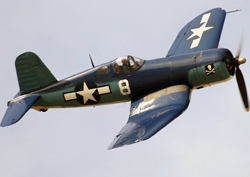Vought
C L I C K T O E N L A R G E
Building a carrier fighter around the largest piston engine available determined the look of the F4U Corsair. The propeller was over 4 meters, 13 feet 6 inches, in diameter, requiring long landing struts. But carrier landings are too harsh for relatively spindly landing gear so the wings were bent into an inverted gull wing, shortening the length needed for wing mounted struts. Keeping the plane as small as possible meant cramming the engine, turbocharger and a fuel tank in front of the pilot making for a nose extending over 4 meters, 14 feet, beyond the cockpit.
Picture: 980 x 705 - Richard Seaman
Crew: 1
Power: Pratt & Whitney 2000 hp R-2800-8 18-cylinder
Double Wasp two-row air-cooled radial engine
Max. Speed: 671 kph / 417 mph
Ceiling: 11,247 m / 36,900 ft
Range: 1633 km / 1015 miles
Climb: 951 m / 3120 ft per minute
Weight -
Empty: 4074 kg / 8982 lb
Max. Take Off: 6350 kg / 14,000 lb
Size -
Wingspan: 12.5 m / 41 ft
Wing Area: 29.17 sq m / 314 sq ft
Armament:
6 - 12.7 mm / 0.5 in machine guns w/2350 rounds total or
4 - M2 Cannon (C model)
Within the base of the wing are vents leading to plane's supercharger which diverts the engine's exhaust into turbines that compress air through high speed revolutions. The compressed air is mixed with fuel and forced into the carburetor ensuring the engine gets the same amount of air at high altitude that it would at sea level.
Picture: 679 x 338 - Photo Net
The initial several hundred Corsairs went to the Marines because they failed their initial carrier suitability tests. The F4U had a dangerous tendency to bounce when landing on the carrier's deck and the long nose obstructed the pilot's forward view trying to land. The pilot's position was raised up and landing characteristics were improved and although the Navy eventually accepted the F4U for carrier duty they were already quite happy with the F6F Hellcat in the fighter role.
Picture: 595 x 603 at 96 dpi - Damage Inc
The Marines preferred the F4U in the Pacific as it had both speed and agility. It was the first American aircraft that was more than a match for the Japanese Zero. It had an overall 11:1 kill ratio over opposing aircraft during World War II. Later models were fitted with wing pylons for the ground attack role in the Pacific island hopping campaign. It was widely depended upon in this role later in Korea and by the French against the Viet Minh in the 1950s.
Picture: 900 x 704 at 96 dpi - Damage Inc
The unusual sound made by the F4U in its attack approach led to the nickname Whistling Death given it by Japanese troops. Besides rockets it could also mount several hundred pounds of bombs beneath each wing. Intended by the Navy as their fighter it proved a better fit with the Marines and they converted all their squadrons to it within six months of its introduction.
Picture: 1024 x 768 - Reddit
Designing an aircraft to go up against the best of the best in a life or death encounter is never routine. The specifications to be met challenge available technology and drawing board solutions never anticipate all the eventual problems faced in harsh reality. Remedies can be stubbornly elusive adding months to development time. Many designs simply fail and their expensive prototypes are discarded. Marine ace Major Gregory "Pappy" Boyington gained fame downing Zeros using the F4U but the Corsair's chief designer Rex Beisel deserves a couple columns of print, as well.
Picture: 1280 x 1024 - Warbird Depot









No comments:
Post a Comment